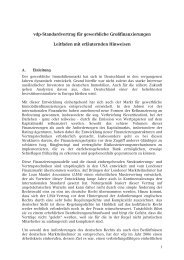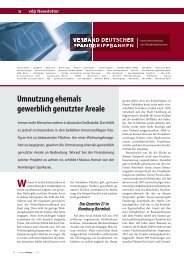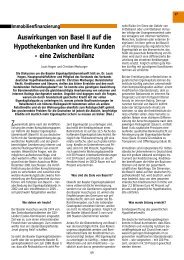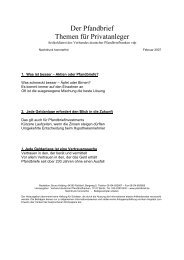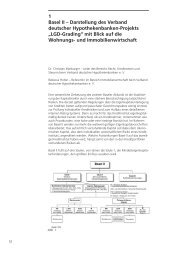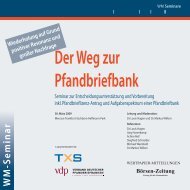The Pfandbrief 2011 | 2012
The Pfandbrief 2011 | 2012
The Pfandbrief 2011 | 2012
Create successful ePaper yourself
Turn your PDF publications into a flip-book with our unique Google optimized e-Paper software.
and to meet liquidity management costs. Over and above this, it is at the issuer’s discretion to<br />
maintain further excess cover. Most rating agencies stipulate this as a precondition for awarding<br />
top ratings to <strong>Pfandbrief</strong>e.<br />
Unlike those for Mortgage Backed Securities, cover pools for <strong>Pfandbrief</strong>e are dynamic. This<br />
means their composition changes over time, depending on the maturities and the assets that<br />
are newly registered and included in cover. Loans are repaid or are removed from the cover for<br />
other reasons, to be replaced by new loans, and new lending is included in cover to enable the<br />
<strong>Pfandbrief</strong> Bank to issue new <strong>Pfandbrief</strong>e. Thus, the cover pools have to be actively administered<br />
to assure matching cover at all times. <strong>The</strong> <strong>Pfandbrief</strong> Act stipulates that risk management<br />
systems must be installed to identify, assess, control and monitor the relevant risks such as<br />
counterparty risks, interest rate, currency and other market price risks, operational risks and<br />
liquidity risks (§ 27 <strong>Pfandbrief</strong> Act).<br />
§ 27 of the <strong>Pfandbrief</strong> Act covers the general handling of different risks inherent to the<br />
cover pools. Whereas specific limits are stipulated for interest rate, currency and credit risks,<br />
the liquidity risk had originally not been explicitly addressed. Liquidity risk is defined here as<br />
the risk that, in the event of the <strong>Pfandbrief</strong> Bank’s insolvency, the cover pool will be unable to<br />
provide sufficient liquidity to ensure the timely servicing of the <strong>Pfandbrief</strong>e maturing in the<br />
months to follow, e.g. large-volume Jumbo <strong>Pfandbrief</strong>e. Rating agencies and investors saw in<br />
the absence of a provision dealing explicitly with this possibility a weakness in the <strong>Pfandbrief</strong><br />
Act, occasioning rating agencies to call for excess overcollateralization to cover this liquidity<br />
risk.<br />
Against this background, under the 2009 amendment a new provision to limit the shortterm<br />
liquidity risk was added (§ 4 par. 1a <strong>Pfandbrief</strong> Act). Accordingly, the maximum cumulated<br />
liquidity need of the next 180 days 1) must be secured by assets that can be used as excess<br />
overcollateralization, as well as other liquid cover assets. Liquid assets are considered to be all<br />
the financial instruments entered in the cover register which the European System of Central<br />
Banks (ESCB) has classified as being eligible for central bank credit (ECB-eligible assets). Various<br />
limits do not apply to such assets that are entered in the cover register solely to manage<br />
liquidity.<br />
15<br />
Transparency of the Cover Pools<br />
To give investors as exact and up-to-date a picture as possible of the composition of the cover<br />
pools and the <strong>Pfandbrief</strong>e outstanding, <strong>Pfandbrief</strong> Banks are required to publish certain<br />
information on a quarterly basis and additional data annually. Such information includes, for<br />
instance, the regional distribution of the cover assets, the type of properties lent against, the<br />
debtors of public-sector liabilities and the amount of claims that are at least 90 days in arrears.<br />
This allows <strong>Pfandbrief</strong> creditors to compare the cover pools of different <strong>Pfandbrief</strong> Banks. <strong>The</strong><br />
2010 amendment of the <strong>Pfandbrief</strong> Act provided for a period of one month after the end of<br />
each quarter. <strong>The</strong> quarterly report must be published within this one-month period; this period<br />
will be extended to two months for the fourth quarter.<br />
1)<br />
<strong>The</strong> draft law originally provided for a liquidity buffer of 90 days (Bundesrat printed paper 16/11130 of December 1, 2008, p. 30).<br />
Because, during the course of the financial crisis, this was considered too short the Bundestag followed the proposal made by the<br />
Central Credit Committee of the Leading Associations of the German Credit Industry (ZKA) and increased this reserve to 180 days.




